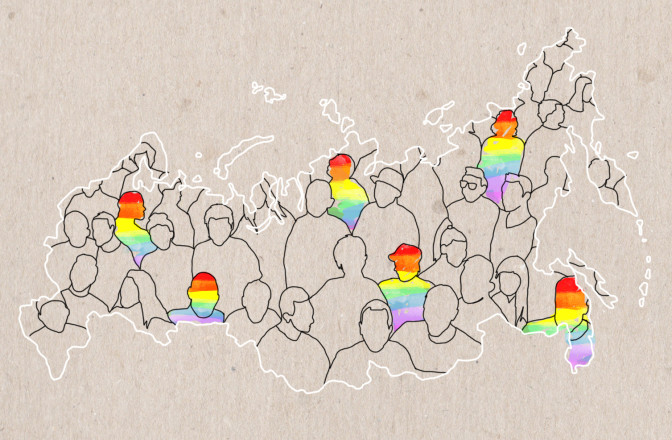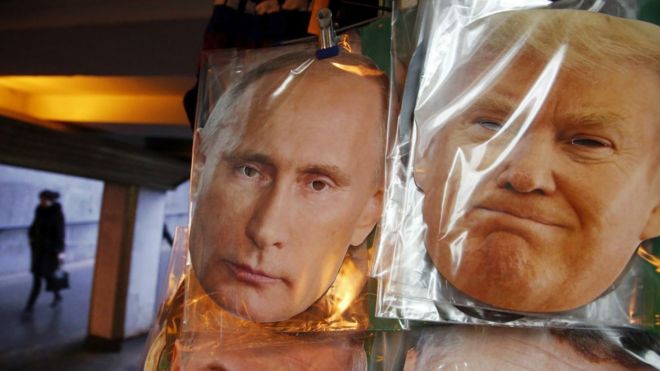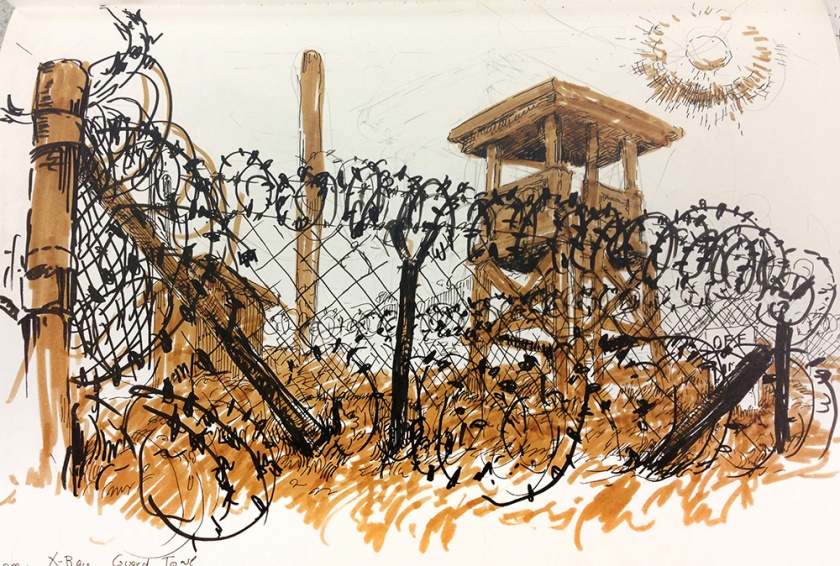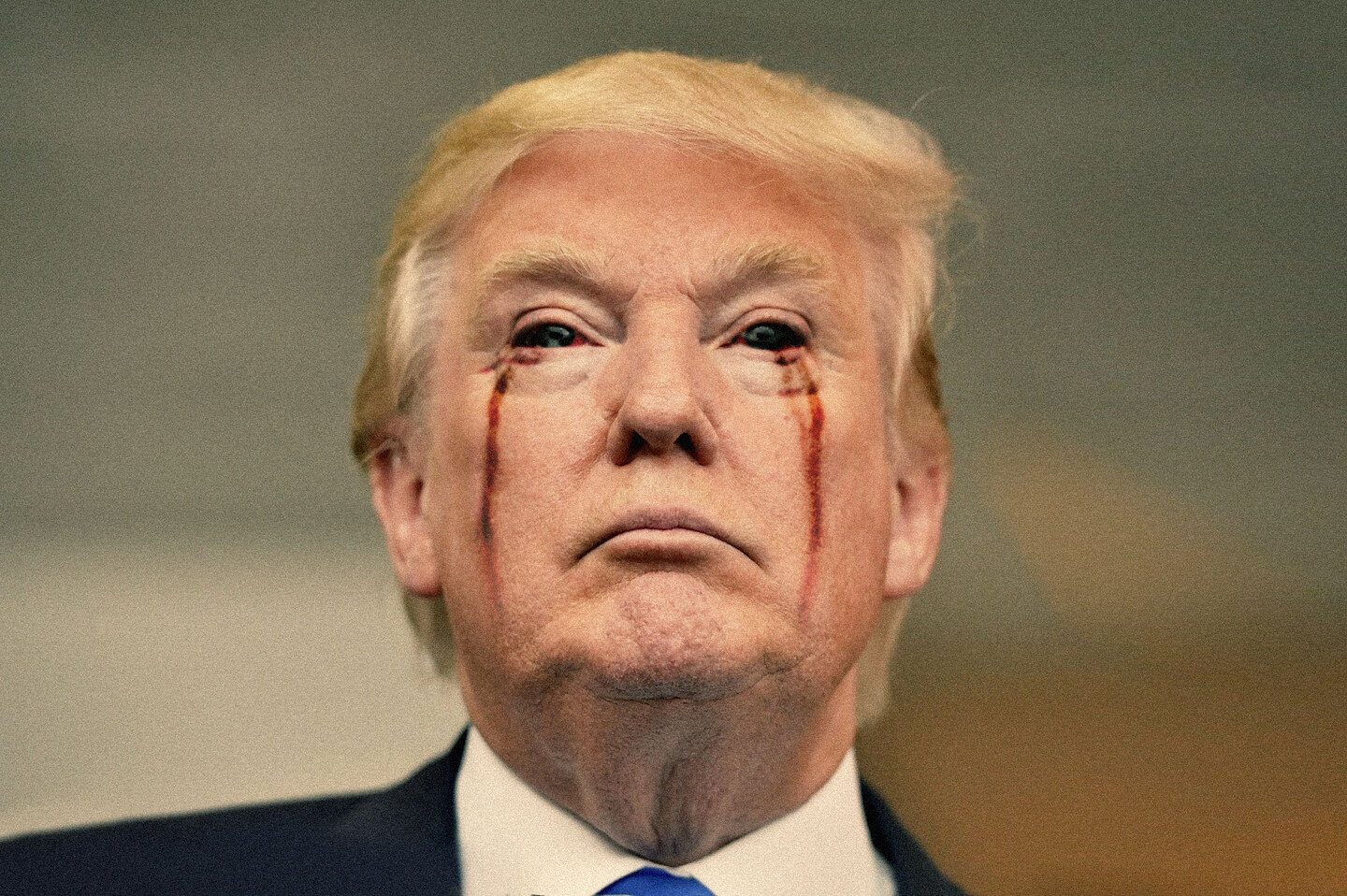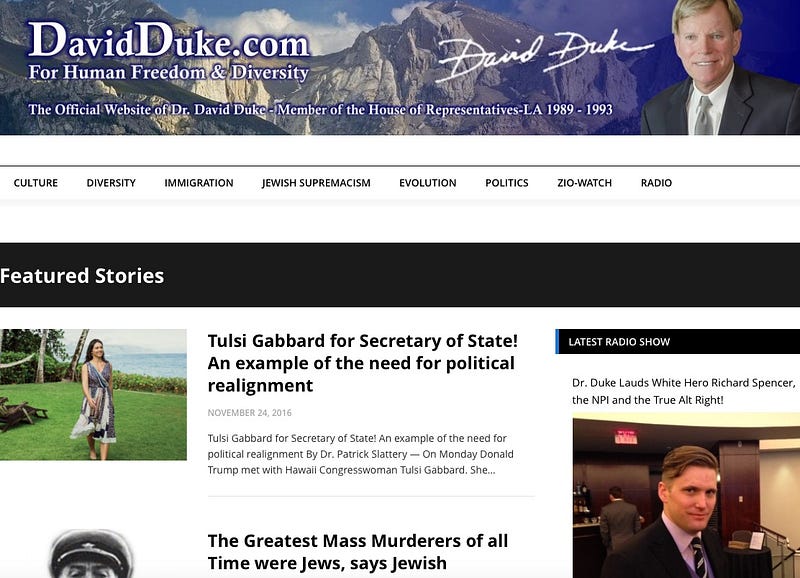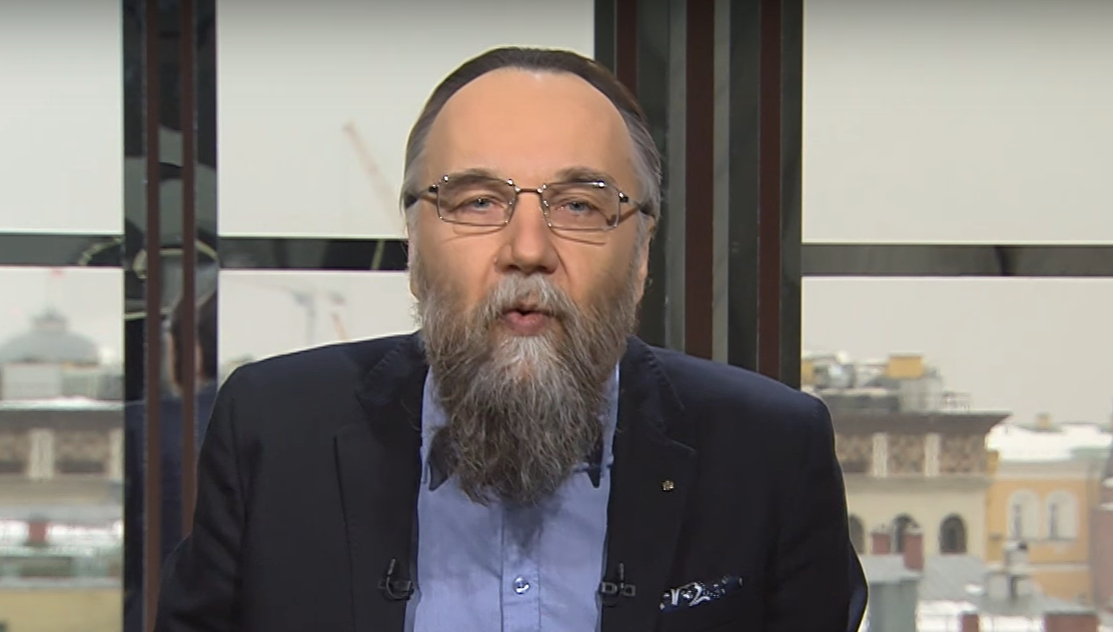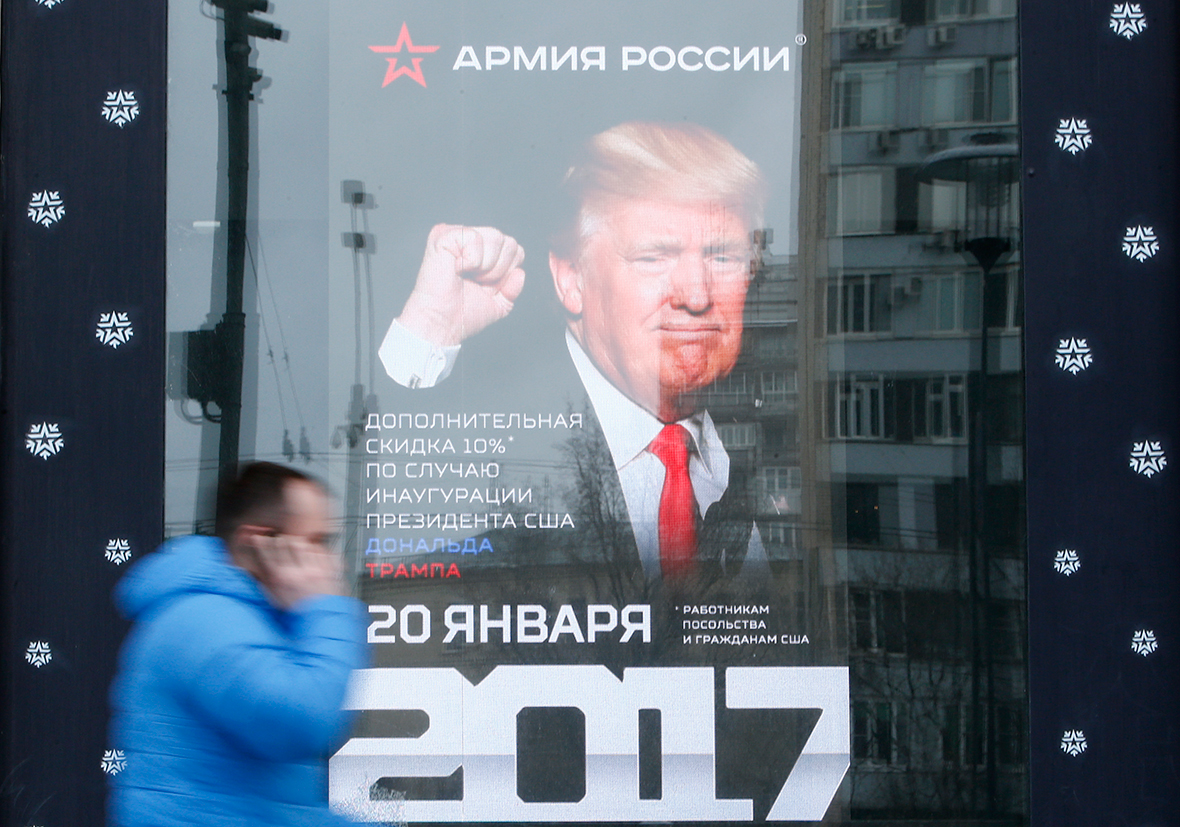The Rise of the ‘Traditionalist International’: How the American Right Learned to Love Moscow in the Era of TrumpBy
Casey Michel Introduction
IntroductionFollowing the election of Donald Trump to the presidency, two American contingents appeared to stand ascendant in the U.S.: white nationalists and the Religious Right. The former, ideological descendants of the Ku Klux Klan and Jim Crow-era legislators, would like to return white supremacy to both state and federal law—or, barring that, break off part of the U.S. to form a white ethno-state wholesale. The latter, meanwhile, would allow Christian fundamentalism to become the U.S.’s de jure national religion, with attendant legislation targeting LGBT and minority religious communities alike. Both white nationalists and the Religious Right tossed vociferous support behind Trump’s candidacy during the recent presidential election, and both contingents thrilled at Trump’s unexpected victory, as well as the authoritarian bent he’s quickly brought to the executive branch.
However, Trump is not the sole leader that both of these cohorts vocally support. Indeed, for America’s white nationalists and for many within the Religious Right, there is only one country, and one leader, worth emulating. Rather than model their goals solely on a glorified Confederate past or lavish praise only on defeated fascist regimes in Europe, the figureheads of America’s far-right have found a new lodestar in Moscow.
The examples of far-right Americans praising the Kremlin are as myriad as they are obvious. For Richard Spencer, the coiner of the term “Alt-Right” and a leader of the emerging white nationalist faction it represents, Russia is both the “sole” and “most powerful white power in the world.” Matthew Heimbach, head of the white nationalist Traditionalist Worker Party—and someone who, like Spencer, desires the creation of a whites-only nation-state within the U.S.—believes Russian President Vladimir Putin is the “leader of the free world,” one who has helped morph Russia into an “axis for nationalists.” Harold Covington, the white supremacist head of the secessionist Northwest Front, recently described Russia as the “last great White empire.” And former Ku Klux Klan Imperial Wizard David Duke has said he believes Russia holds the “key to white survival.”
Of course, the idea of Russia as some sort of “white empire” is, to an extent, merely a fantasy held by American and European white supremacists. Not only does Russia routinely jail and sideline the most outspoken members of its domestic white supremacist movements, but Putin routinely offers support to Russia’s ethnic and religious minority communities when it suits his political aims.
Nonetheless, over the past few years the Kremlin has increased both rhetorical and financial support for far-right movements across the West, including in the U.S. These movements encompass a wide range of right-wing ideologies, such as the white nationalists who have seen Kremlin-tied organizations provide everything from official backing to logistical support for trans-Atlantic networking in order to bring like-minded bigots together. The Kremlin, through financing and conferences, has also built up ties with America’s Religious Right, whose leaders, despite rejecting the overtly race-based visions of individuals like Spencer, share white nationalists’ admiration for Russia’s authoritarian ruler.
At the moment, any financial links between the Kremlin and America’s white nationalist and Religious Right contingents remain minimal, or obscured through assorted third parties. But the organizational support the Kremlin has lent to these groups remains both under-studied and underappreciated—even as, over the past few years, it has noticeably increased. (In this report, we use the term “white nationalism” to describe the American movement that would seek, either via secession or changes in policy, to re-impose explicit white supremacy in all or part of the country. This group includes those like Heimbach, Spencer, and Covington, who all propose cleaving off swaths of the U.S. to create a whites-only state. We consider large segments of the “Alt-Right,” which melds racism, misogyny, and rank anti-Semitism with aggressive online trolling, to be a distinct but clearly related form of white nationalism.)
Before detailing such admiration—and mutual support, financial and otherwise—between Russia and the U.S.’s far-right, it’s worth examining the appeal Moscow maintains with these right-wing movements. The Kremlin, most especially in Putin’s third term, has presented itself as a bulwark of so-called “traditional” values, including opposing LGBT rights, dissolving the barriers between church and state, and entrenching domestic dictatorship with tactics like fraudulent elections and the stigmatization of domestic activists who advocate for progressive legislation.
Likewise, and despite Putin’s domestic support for minority constituencies, Moscow over the past few years has managed to create an image of itself abroad as a center for these values against a libertine West—of a white, Christian nation-state, undeterred by legal niceties, standing up against the nefarious forces of “religious tolerance” and “gay rights.” Even something like Russia’s annexation of Crimea—recognized by only a handful of dictatorships, including North Korea, Zimbabwe, and Kazakhstan—appeals to those members of the West’s far-right who view the illegal land-grab as a throwback of empire and expansion: of might making right.
To be sure, there are different avenues of Russia’s appeal for both the Religious Right and white nationalists in the U.S. For the American Religious Right, as detailed below, Putin is the foremost defender of nominally “traditional,” and nominally Christian, values. For white nationalists, Putin—via both his illiberalism and anti-Western bent—remains a political polestar, whose authoritarian model should be implemented within the U.S. And such support didn’t arise in a vacuum. Since he returned to the presidency in 2012, Putin has made a concerted effort to establish his country as a center for religious, especially Christian, conservatives throughout the world, most notably for those who oppose any legal or public support for same-sex relationships. This shift has taken the form of legislation that prioritizes the interests of the Russian Orthodox Church, that rolls back abortion rights, and that sidelines attempts within the LGBT community to obtain any kind of societal acceptance. Even Moscow’s ban on Americans adopting Russian children managed to gain support within the U.S.’s far-right, with anti-equality Christian activists praising Putin’s move as one that would prevent children from living with same-sex parents.
Likewise, Putin’s attempts to distance himself from the West with this focus on “traditionalism” both mirror and reinforce the increasing geopolitical distance Moscow has created between itself and Western governments, as seen most explicitly with Russia’s ongoing occupation of Crimea. All the while, those close to the Kremlin have been expanding their outreach to members of Europe’s far-right, ranging from directing funding to France’s National Front party to inviting Hungary’s far-right Jobbik party to visit the Crimean peninsula, allowing the West’s far-right an opportunity to support Moscow’s claims to Ukraine’s peninsula.
Indeed, the burgeoning affinity within America’s far-right for Moscow parallels a phenomenon we’ve seen play out through Europe over the past few years. From far-right actors in Sweden, the Netherlands, and Austria, as well as neo-fascist contingents in Serbia and the United Kingdom—even extending to populist movements in countries like Italy and Germany—those among Europe’s most outspoken right-wing contingents carry an increasing affinity for Moscow. “Prior to 2010, one would be hard-pressed to find public statements in praise of Putin by far-right leaders,” Alina Polyakova recently noted in Foreign Policy. “Today, they are commonplace.” Such praise often overlaps, as with the American example, with certain policy prescriptions, from barring immigration to fracturing the European Union and NATO wholesale. Unwinding the trans-Atlantic liberal order has become a clear goal during Putin’s third term—and so too has this become the primary goal linking Europe’s mushrooming hard-right factions.
As such, far-right Americans’ newfound ardor for Moscow is of a piece with their European equivalents. And now, the ideological affinity and logistical ties between these right-wing movements and Russia’s leadership have taken on a new significance in the era of Trump.
Without fail, every one of the American far-right leaders discussed in this report—as disparate as their ideologies may be—supported Trump’s presidential candidacy. And Trump has done little to dissuade these individuals, and these movements, that they won’t have a sympathetic ear in the White House. Nor, of course, has Trump done anything to disabuse Putin of the idea that Moscow suddenly has a regressive, illiberal friend in Washington—a partner who will provide cover for those far-right Americans, those white nationalists and Religious Right figures, with whom the Kremlin and its allies are already working to build ties.
White Nationalists, Trump, and PutinIn early 2015, the leading lights of Europe’s far-right, including members of Austria’s Freedom Party and Greece’s Golden Dawn, met in St. Petersburg, Russia. The meeting, on its own, was one of the most notable gatherings of Europe’s regressive, xenophobic far-right in years. The group organizing the event, the Russian Imperial Movement, is itself an outgrowth of groups like Rodina—a Russian political party founded by Deputy Prime Minister Dmitry Rogozin, a high-ranking Kremlin official charged with running Russia’s defense industries.
Among the Americans attending the conference was Jared Taylor—one of the foremost proponents of “race realism,” which claims genetic superiority for Europeans—who spent his time at the conference condemning America’s liberal policies, including support for same-sex relations. Taylor was joined by Sam Dickson, a former KKK lawyer and another prominent face of American white supremacism. Echoing his European counterparts, Dickson used the opportunity to praise Putin for helping encourage higher birthrates, and exhorting his compatriots to preserve “[the white] race and civilization.” (It remains unclear who paid for the Americans’ travel.)
The conference was, more than anything else, a networking event—and an opportunity for the trans-Atlantic far-right to unite in support of rolling back liberal policies, expelling non-whites from their countries, and unwinding Western democracy. It was also an opportunity for attendees to vie with one another in their praise for the Kremlin, and to lay that much more groundwork in the pursuit of what Matthew Heimbach, as detailed below, has called the “Traditionalist International.”
It’s worth noting that the current crop of leaders within American white nationalist circles—which includes Spencer and Heimbach, as well as, to lesser extents, Taylor and Dickson—relies on rhetoric that is different from that of previous iterations of the white supremacist movement. For instance, this new crop of white nationalists places less explicit emphasis on the notion of the supremacy of one race over any other. Spencer and Heimbach attempt to mask their white supremacy by professing co-equal respect for whites and non-whites alike, and claim that they are merely fighting for an all-white state alongside attendant states for other races. “I support white power, black power, brown power, and yellow power,” Heimbach recently said. “All races should be the dominant political force in their region. That is why America needs to be divided into smaller, ethnically and culturally homogeneous states. … We need to stop the hate and separate.”
Yet Spencer and Taylor, despite the claims that their movement has little to do with traditional white supremacy, have both espoused bogus biological theories about racial difference—a classic tool of white supremacists—in attempts to justify their view that the U.S. must undergo a separation of the races. Interestingly, and perhaps predictably, there is no universally accepted definition of “white” that exists within the white nationalist movement. For example, while Spencer considers his wife, Nina Kouprianova, to be white, other outspoken members of the white nationalist movement—including Southern nationalist Greg Johnson—point to Kouprianova’s Georgian heritage as evidence of what they claim is her non-European lineage.
Whatever nominal differences remain between the current crop of white nationalists and holdovers from an earlier era, there was little question about which candidate these contingents preferred in the 2016 presidential election. Duke not only endorsed Trump, but was inspired by Trump to once more run for office. Spencer held a now-notorious rally after Trump’s election that culminated in shouts of “Hail, Trump!” Heimbach, for his part, was accused of violence against those protesting Trump. And Taylor recorded robocalls to rally support for Trump, whom Taylor said would see that immigrants should be “smart, well-educated white people” rather than Muslims. In all, America’s white nationalists and white supremacists were effectively uniform in their support for Trump.
But white nationalists’ support for Trump didn’t stem solely from his claims that Mexican immigrants were “rapists,” his vow to block Muslims from traveling to the U.S., or his sharing of faulty, racially charged crime statistics with millions of followers on Twitter. Indeed, much of Trump’s appeal for white nationalists can be found, unsurprisingly, in incendiary outlets like Breitbart, recently led by Trump’s chief strategist Steve Bannon. (Among the tags Breitbart uses for stories: “black crime,” “feminazi,” and “left wing thugs.”) White nationalists also viewed the foreign policy Trump espoused during the presidential campaign—a mix of America First isolationism, appeasement of Russian expansionism, and aggressive distrust of multilateral organizations—with glee.
And they all—white nationalists and Religious Right figures alike—looked fondly on what appears to be Trump’s mutual admiration of their authoritarian hero, Putin.
Alexander Dugin and ‘The Eternal Rome’A key player in cementing ties between Moscow and American white nationalists like Richard Spencer and Matthew Heimbach is Alexander Dugin, erstwhile Kremlin confidant and Russia’s most well-known neo-fascist ideologue, whose work maintains an outsized influence both in Moscow and within the EU’s far-right.
Dugin’s primary claim to notoriety—when he’s not calling for genocide against Ukrainians, at least—stems from his re-formulation of the theory of “Eurasianism,” a geopolitical theory that posits Russia, an “Eternal Rome,” as a bulwark of conservatism against a weak-kneed West. While Dugin’s influence within the Kremlin remains over-hyped, one of his books, “Foundations of Geopolitics,” is assigned to every member of Russia’s General Staff Academy, among other Russian military institutions.
Since the Crimean annexation, Dugin’s views—especially those placing Moscow as the primary barricade against a global assault of progressive values—have gained notable traction within like-minded movements in Russia and the U.S. For instance, Alex Jones, the face of conspiracy site InfoWars and a full-throated supporter of Trump, appeared with Dugin on Russian television in December 2016 to discuss Trump’s election. As Dugin told a supportive Jones, “Anti-Americanism is over! Now the people of free America, free Russia, all anti-globalists of the world, should build a new world—a new architecture!”
Richard Spencer and Nina KouprianovaFor those who have just discovered the increasingly visible white nationalist movement in the U.S., Richard Spencer is one name that generally rises to the fore, thanks to the glut of press attention he received around Trump’s presidential candidacy. Spencer, who splits his time between Montana and Virginia, runs a “think tank” called the National Policy Institute (NPI), as well as the primary white nationalist periodical, Radix Journal.
The Virginia-based NPI, founded in 2005, claims to be an “independent organization dedicated to the heritage, identity, and future of people of European descent in the United States, and around the world.” Spencer has used NPI to push both rank anti-Semitism and dreams of monoracial statehood in America, stating that the creation of a whites-only state is his “grand goal.” He’s said that such a state will be crafted through “peaceful” ethnic cleansing, although he has admitted that such “peaceful” ethnic cleansing could involve bloodshed.
As a 2016 New York Times article described, Spencer spent a celebratory post-election rally in Washington “rail[ing] against Jews” and declaring that the U.S. “belonged to white people, whom he called the ‘children of the sun.’” At the same event, Spencer led supporters—many of whom responded to Spencer with Nazi salutes—in denouncing the “Lügenpresse,” a Nazi-era descriptor for the media, before leading his followers in chants of “Hail, Trump!”
Spencer’s preferred policies also echo the Kremlin directly. To wit, he has lifted language from Moscow in describing Ukraine’s 2014 EuroMaidan revolution—which he has claimed was financed by liberal American philanthropist George Soros—as a “coup,” and has called to break up NATO. Spencer has also noted that he “admire[s]” Putin, and has described Russia as the “sole white power in the world.”
Spencer has additionally begun writing for Dugin’s website, including a recent article describing the “purpose and meaning of the Alt-Right movement.” Further, in 2014, Spencer attempted to organize a white nationalist conference in Budapest featuring a number of European white nationalists and neo-fascists, including members of Hungary’s Jobbik party—a party that supplied putative “election observers” to the 2014 Crimean “referendum” on joining Russia. (The referendum, as mentioned above, was recognized by only a handful of autocracies and Russian client-states.) Spencer invited none other than Dugin to speak at the conference, but Western sanctions prevented Dugin from entering the country.
Spencer is also married to Nina Kouprianova, who was born in the Soviet Union and educated in Canada. (The two are currently separated.) Kouprianova, who writes under the nom de plume Nina Byzantina—and is occasionally identified as Nina Spencer—has not only spent the past few years defending regressive Kremlin policies on her popular social media accounts, but has additionally translated Dugin’s work into English. Indeed, the only books Kouprianova lists among those she’s translated are those by Dugin.
While she says that she has never met Dugin, Kouprianova has called him a “well-educated scholar” unfairly maligned by the “Western media.” Kouprianova has been outspoken in defense of the Kremlin’s anti-liberal policies, as well as her husband’s neo-fascist ideas, and has defended Moscow’s militarized policies in both Chechnya and eastern Ukraine, the latter of which she has consistently referred to as a “liberation war.”
Matthew HeimbachMatthew Heimbach, the Indiana-based head of the Traditionalist Worker Party, has been called the “Little Fuhrer” by the Southern Poverty Law Center. Among the Traditionalist Worker Party’s goals: revoking birthright citizenship, creating a separate whites-only homeland, and the removal of U.S. authority from “occupied territories” like Hawaii.
The 26-year-old Heimbach initially gained notoriety in 2013 when he founded a “White Students Union” at Towson University, and received further coverage for a 2016 incident in which he was caught shoving an anti-Trump protester at a Trump rally in Kentucky.
Heimbach has gone to even greater lengths than Spencer or Kouprianova in praising Putin’s machinations. On Twitter, Heimbach has referred to Putin as the “best European leaders [sic] of the 21st century,” claiming that Russia, under Putin, has demonstrated a “rediscovered purpose of supporting Tradition, Christianity, and identity.” Heimbach has peppered his tweets with #HailPutin and #PutinForTsar hashtags, and, in 2015, led a rally in which Confederate and Russian Imperial flags flew side by side. He has further tweeted out photos of Confederate and Russian flags paired together, and has shared a photo of himself and a handful of “comrades” smiling in front of the flag of “Novorossiya,” the fanciful political entity Russian-backed separatists have attempted to create in eastern Ukraine. Heimbach has even called Russia the white nationalist movement’s “most powerful ally,” as well as shared a photo of himself holding Dugin’s book and the flag of the neo-Confederate League of the South. In 2016, Heimbach described Putin as both the “leader … of the anti-globalist forces around the world” and the “leader of the free world,” one that has now morphed into an “axis for nationalists.”
For good measure, Heimbach has also said that he’d prefer the U.S. fracture into multiple race-based enclaves, citing the USSR’s dissolution in 1991. (While it’s beyond the purview of this report, it’s worth noting that Moscow has also begun funding efforts to organize America’s domestic secessionists, who wish to rupture the U.S. on a state-by-state level.)
It is Heimbach’s conception of Russia as this “axis for nationalists” that has helped him collaborate with like-minded white nationalists in Europe. He has conducted at least three tours of Europe, meeting with far-right members of Greece’s Golden Dawn, Romania’s New Right, and Germany’s National Democratic Party, among others. In the fall of 2016, Heimbach planned his first visit to Russia, seeking to attend the World National Conservative Movement conference, a reprise of the 2015 conference attended by Taylor and Dickson. The organization behind the conference, again, was the Russian Imperial Movement. This group, an outgrowth of Rogozin’s efforts, describes its ideology as “Christian Orthodox imperial nationalism.” Its stated goals include dissolving both the EU and NATO. (According to researcher Anton Shekhovtsov, the Russian Imperial Movement also maintains ties with former separatist leaders in Ukraine—one of whom was funded by ultra-Orthodox oligarch Konstantin Malofeev, who has maintained his own links with those building ties with the American Religious Right.) Heimbach noted that the planned conference would include “a broad coalition of all ethno-nationalists—all nationalists that reject neoliberalism, and reject globalism, coming together as a united front, based out of Russia.” That conference ended up being postponed, but Heimbach has continued piling on his praise for Moscow.
One person who has taken note of Heimbach’s work is, unsurprisingly, Dugin. In 2015, at the official unveiling of the Traditionalist Worker Party, Heimbach managed to host a Skyped-in speech from Dugin, whose discussion was titled “To My American Friends in Our Common Struggle.”
David DukeDavid Duke, perhaps the most prominent face of outright white supremacy in the U.S., has described Russia as the “key to white survival,” and has added that, “Of the many capital cities of Europe, it is accurate to say that Moscow is the Whitest of them all.” According to the Anti-Defamation League, Duke also views Russia as a nation that “presents an unmatched opportunity to help protect the longevity of the white race.” Duke—who has claimed that he lived in Russia for five years, and saw one of his books sold in the Duma—has praised Putin’s policies on Twitter, including Russia’s actions in Syria, and called for an “alliance” between the U.S. and Russia. Duke has additionally met Dugin on at least one occasion, although the circumstances of this meeting remain clouded.
Meanwhile, Business Insider’s Natasha Bertrand has reported that Duke maintains an apartment in Moscow, one that he has sub-leased to Preston Wiginton, an American neo-Nazi who has helped host lectures from both Spencer and Dugin—the latter, again, via video—at Texas A&M University over the past two years.
Secondary figures within the American white nationalist movement have similarly expressed their admiration for Putin while promoting propaganda from the Kremlin-funded media. Harold Covington—the head of the Northwest Front, an organization seeking to lead a white supremacist secession movement in the Pacific Northwest—has described Russia as the “last great White empire.” And Mike Cernovich, whom The New Yorker calls the “meme mastermind of the Alt-Right,” has repeatedly shared material from Kremlin-funded media on his popular Twitter account, often accompanied by Kremlin-friendly commentary. In October, Cernovich tweeted, “Putin is a larger than life alpha male who loves his country and will fight to defend it. Why *don’t* you admire him? Brainwashing.” A few weeks later, Cernovich shared a story from Kremlin-funded Sputnik News, commenting, “American Media (terrorist organization) v. Putin. I believe Putin!”


